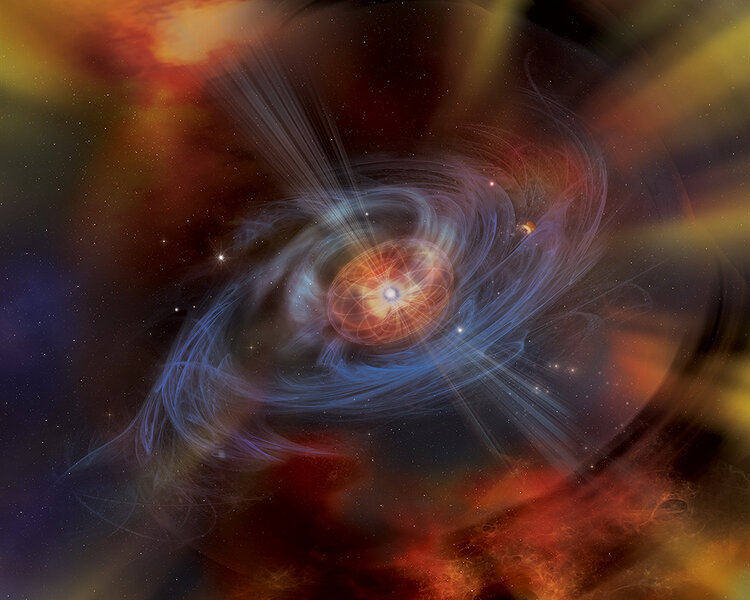Create a free profile to get unlimited access to exclusive videos, sweepstakes, and more!
One of the brightest pulsars ever seen was somehow missed despite being right next door
Luminous beacon was probably dismissed as a galaxy.

There are times when you miss something right in front of your face. We all do it, but you’d think it would be tougher if that thing is a phenomenally luminous pulsar repeatedly screaming its existence into your brain several times a second.
And that’s just the situation with PSR J0523−7125.
It’s a pulsar, a special kind of neutron star. As I’ve written before:
Pulsars are neutron stars, the incredibly dense corpse of the core of a massive star that exploded as a supernova. The outer layers of the star get blasted away, but the core itself collapses. If the core has less than about three times the Sun’s mass it will become a ball of neutrons very roughly 20 kilometers wide. This makes it ultradense; a cubic centimeter of it — the size of a six-sided die — will have a mass of about 100 million tons, about the same as if you took every car in the United States and crushed them down until all together they were the size of a sugar cube.
Neutron stars tend to spin rapidly, and have powerful magnetic fields that can be trillions of times stronger than Earth’s. This sets up a lot of different phenomena; one is that this powers incredibly strong beams of radiation that blast away from the magnetic poles of the star, which sweep around the sky due to the neutron star’s rotation like a pair of lighthouse beams. When these beams pass over Earth we see a blip of light, a pulse, hence the term pulsar.
Pulsars can be strong sources of radio waves, and searching in that part of the spectrum has been a traditional way to find them. A team of astronomers (led by a PhD candidate named Yuanming Wang) wanted to look for pulsars in the Large Magellanic Cloud, which at 170,000 light-years away is a smallish companion galaxy to our Milky Way [link to paper]. They looked in data from the Australian Square Kilometre Array Pathfinder, or ASKAP, a radio observatory that is a technology testbed for the more ambitious Square Kilometer Array, which is scheduled to begin operations in 2027.
ASKAP is pretty sensitive, and the astronomers looked for sources that were highly variable, changing their brightness over time. They found 27 that were seen not only to vary but were also small, unresolved in the data, as you’d expect for a pulsar. In two of those sources the observations showed the radio waves were also strongly polarized, meaning in those sources the radio waves were aligned, which also suggests each source has a strong magnetic field.
One was identified as a star, but the other was previously unidentified. They followed up with observations using other telescopes, and to their surprise they could see it was a pulsar. It has a period of 322.5 milliseconds, so it spins three times per second — a not unsurprising rate.
But the distance was another surprise. As the radio pulses travel through space, they pass through the thin gruel of charged subatomic particles between the stars. This delays the waves a tiny fraction, and the amount of the delay depends on how much material the waves interact with as well as the wavelength of the light. What we see on Earth is broadening of the wavelength of the radio waves. This is called the pulsar dispersion measure.
The key part is that if we know how much material there is between us and the source then that can give the distance to the pulsar! The farther away the pulsar the more stuff there is to disperse the waves, so the distance can be measured.
They applied this technique to their pulsar and found it lies smack dab inside the Large Magellanic Cloud!
Given how bright it is, this makes it among the most luminous pulsars known. It was missed before because it has some unusual properties; its brightness drops off steeply with frequency, and the pulses are weirdly broad. Usually a pulse is very short in duration — BLIP! — but this one is much longer, lasting for a third of the total pulsar rotation. That means the pulsar beams are not tightly focused as they usually are, but instead extremely wide, more like squat cones.
It’s not completely clear why it was missed — I’ve seen some articles online saying it was mistaken for a galaxy, but that’s not mentioned in the research paper or original press release. It may have been overlooked because, as a tiny bright dot in the data, it does look like literally millions of distant galaxies blasting out radio waves. So that’s possible, even likely, but it’s not like someone analyzed it carefully in the past and concluded it was a galaxy. It was just one bright source among many.
Still, it’s funny that such a bright source had been missed, but the good news is that it shows the technique the team used works, and may make it possible to find more pulsars inside the Milky Way as well as extragalactic pulsars. The vast majority known are inside our galaxy, unsurprisingly, since they’re close to us. Finding them in other nearby galaxies will give us insight into their stellar populations, the distribution of gas inside them, and more.
Plus learning more about pulsars. They’re amazing little beasts, the size of a small city but able to be spotted hundreds of thousand of light-years away… and in some cases even more.




























